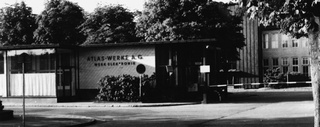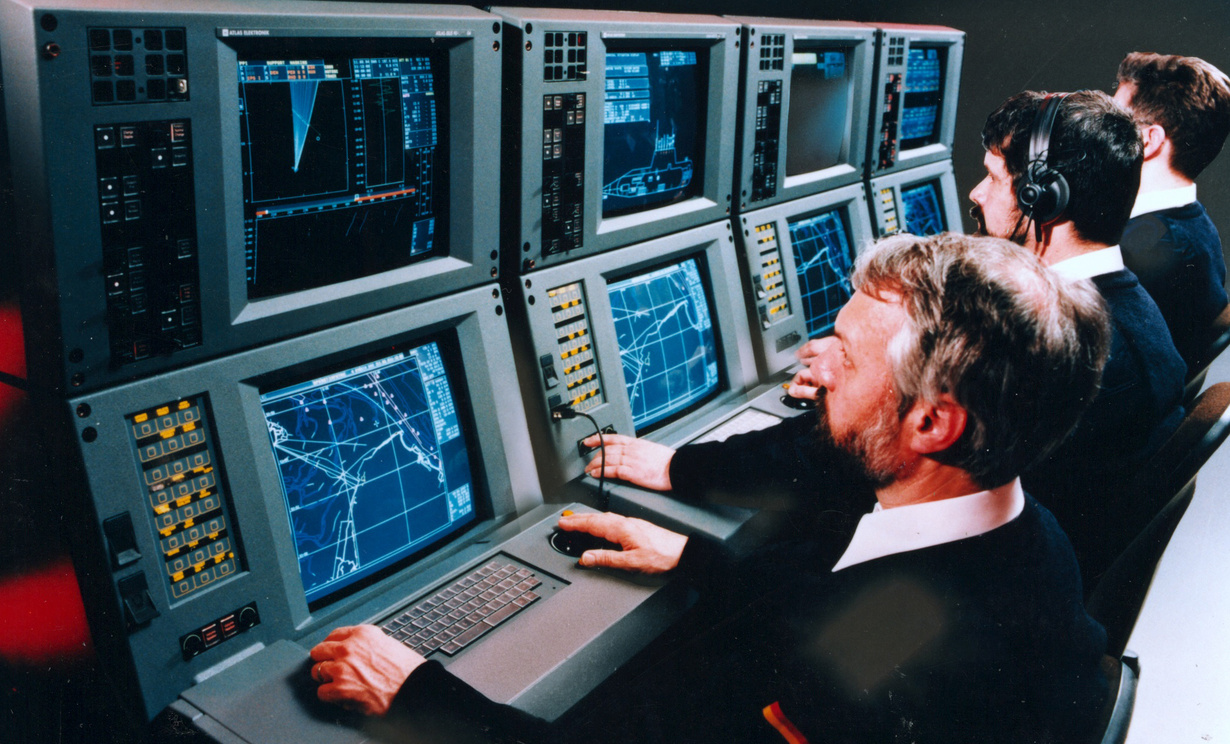

Our company has constantly been expanding its know-how over 130 years and has thus been shaping its future over more than four employee generations. Not only countless technical developments and over 5,000 patents, but also changing economic environments and, not least, the lessons learnt from two world wars, have all contributed towards our wealth of knowledge.
One of these roots goes back to the founding of Allgemeine Elektrizitätsgesellschaft AG, or AEG for short, in the year 1883. Through the subsidiary Telefunken Systemtechnik and its successor DMT Marinetechnik, this branch went on to form part of STN Systemtechnik Nord, established in 1992. STN was one of the direct predecessors of our company as it stands today.
The second “parent” of STN, which was to merge in 1994 with the earlier ATLAS Elektronik GmbH of the same name to form STN ATLAS Elektronik GmbH, was the company Marine- und Sondertechnik GmbH, or MSG, which had been spun off from a part of Messerschmitt-Bölkow-Blohm (MBB) to comply with cartel legislation.
The strongest influence on the development and technological orientation of today’s ATLAS ELEKTRONIK GmbH arose from the ship equipment supplier Norddeutsche Maschinenund Armaturenfabrik, founded in 1902. This company set up an “engineering office for underwater and sound equipment” as early as 1905 and was then renamed to ATLAS-Werke in 1911.What remained of ATLAS-Werke in Bremen after World War II was taken over by Krupp and managed as a dependent business unit of Fried. Krupp GmbH with headquarters in Essen until it was transformed into a separate firm, Krupp Atlas Elektronik GmbH (KAE), in 1983.
This situation changed again in 1991. The Bremer Vulkan Group acquired KAE and changed the name to Atlas Elektronik. Three years later, in 1994, the company merged with STN, which had also been acquired by Vulkan, but in 1992, to form STN ATLAS Elektronik GmbH.
In 1996, Vulkan had to file for bankruptcy. With its full order books, the STN ATLAS subsidiary quickly found two strong new owners in the BAE Systems Group of Britain and the Rheinmetall Group of Germany, emerging practically unscathed from these ashes.
BAE Systems and Rheinmetall split up the company in 2003. The maritime section remaining with BAE Systems was again given the name Atlas Elektronik and the legal form of “GmbH”, a limited liability company. Finally, the British shareholder sold its German subsidiary in 2006 to a consortium consisting of ThyssenKrupp Marine Systems (TKMS) and EADS, now Airbus. The two new owners then incorporated Hagenuk Marinekommunikation and two naval technology sections of the British and German EADS into the company in 2007. In early 2017, thyssenkrupp AG took over the minority shares in ATLAS ELEKTRONIK from Airbus Defence & Space, formerly EADS, and thus is now the shareholder of todays‘ ATLAS ELEKTRONIK GmbH.
The technological history of the present company began in 1905 with the engineering office for underwater and sound equipment, as mentioned above, and the collaboration with the Submarine Signal Company in Boston, USA. The American company owned a number of relevant patents in the field of hydroacoustics. A successful outcome of this cooperation was, for example, an underwater bell that was built in Bremen under licence from the American patent holder.
This navigational aid was of great use to shipping, especially when steaming in foggy conditions. The surveying of the South Atlantic in the years 1925 to 1927 by the research vessel “METEOR” of the German Navy was performed by means of an ATLAS echosounder, with which no less than 67,000 soundings were taken during this measurement campaign.
The collaboration between Boston and Bremen endured until the 1930s, but was interrupted by World War I. The subsequent political changes in Germany meant that ATLAS-Werke had to convert its production entirely to the manufacture of naval equipment. Here the focus was on the development of hydroacoustic systems for the German submarines and surface combatants. The ATLAS underwater sound detector – GHG – was deemed to be of a high technical standard by the US Navy at the end of the war.
The consequences of World War II were devastating for ATLAS-Werke too. A new beginning initially seemed impossible. And yet, after a relatively short time, some 200 employees resumed work again. The office for underwater and sound equipment of ATLAS-Werke became the Electromechanical Department (ELMA), which – after the postwar ban on certain activities had been lifted – produced echosounders for fisheries, as a contribution towards supplying the population with urgently needed foodstuffs. Early in the 1950s, the customers were able to buy a new generation of ATLAS echosounders.
New civilian business segments, such as medical engineering and industrial applications of ultrasound, were added. The reactivation of the old contacts to the Submarine Signal Company, now part of the Raytheon Group, led to the licensed production of navigation radars, a market that exhibited strong growth for ATLAS in the years that followed. This initially resulted in the independent development of a fully transistorised generation of radars.
The accession of the young Federal Republic to the predecessors of the Western European Union and NATO, as well as the formation of the Bundeswehr, were followed by enquiries from government authorities for military uses of hydroacoustic technology. The resumption of developmental work, now for the Federal Navy and the first international customers, and the continued collaboration with American firms then culminated in the independent development of modern sonar systems for submarines and surface combatants. The Electromechanical Department and the company as a whole enjoyed further growth. At the beginning of the 1960s, the ELMA department relocated to the Sebaldsbrück district, at the present headquarters of the company, to form the electronics works of ATLAS-Werke AG.
This positive development was abruptly interrupted in 1963 by the insolvency of the main shareholder of ATLAS-Werke AG, the company Hugo Stinnes Industrie- und Handels GmbH. It proved possible, however, to keep the electronics works, which by then had swelled to 1,300 employees, out of this collapse. One year later, the firm was acquired by Fried. Krupp of Essen.
The subsequent years brought rapid growth in all civilian and military segments. New fields of work, such as test equipment for the Army, expanded the spectrum of activities for this facility of the Krupp Group, which operated under the name FRIED. KRUPP ATLAS ELEKTRONIK. The introduction of digital technology and the arrival of the first own generation of process computers turned software development into a new task for engineers.
With a comprehensive range of active and passive sonars, as well as command and weapon control systems for submarines and surface combatants, and with torpedoes, mine-hunting systems and remote-controlled and autonomous underwater vehicles, the company had earned itself not only an excellent reputation but, in certain respects, also the position of global market leader.

In the 1970s, there were a number of technological innovations. For economical reasons, the company had decided to divest itself of medical engineering and to look for challenges farther afield. In the face of experienced competitors, the company won an order for the new development of fire control computers for the Leopard battle tank. The creation of the Simulation division was another new step. The stimulus for this was a contract awarded by the Federal Navy for the development of a training simulator to serve the weapon system of the Type 206 submarine.
The 1980s not only heralded the independence of Krupp Atlas Elektronik GmbH within the Krupp Group, but also further strong growth in the newly defined divisions for marine electronics, navy, simulation, army and process data systems. From the technological viewpoint, this phase marked the launch of systems engineering, which was understood as the functional combination of different systems to form a unified whole. This system-of-systems approach has characterised the technological philosophy of the company up to the present day.
In the 1990s the workforce had to adapt to new situations several times over. The fusion with Systemtechnik Nord to form STN ATLAS Elektronik GmbH, first as a company of the Bremer Vulkan Group and then, from July 1996, when Vulkan became insolvent, as the subsidiary of Rheinmetall and BAE Systems, extended the company’s technological spectrum by, inter alia, unmanned aerial vehicles and torpedo technology.
In 2003, the two shareholders decided to split up the company. The newly created ATLAS Elektronik GmbH was initially part of the BAE Systems Group and concentrated its efforts on maritime applications. Army technology and simulation were placed in the newly established Rheinmetall Defence Electronics GmbH (RDE). The continued teamwork of the two companies was governed by cooperation agreements.
With a comprehensive range of active and passive sonars, as well as command and weapon control systems for submarines and surface combatants, and with torpedoes, mine-hunting systems and remote-controlled and autonomous underwater vehicles, the company had earned itself not only an excellent reputation but, in certain respects, also the position of global market leader. The civilian fields, comprising primarily the hydrographic systems, involved above all the topics of surveying and harbour safety.
The sale of the company in 2006 by BAE Systems to a consortium consisting of ThyssenKrupp and EADS, now named Airbus DS, again signified an extension of the technology portfolio, especially through the newly acquired Hagenuk Marinekommunikation, with which the secure internal and external transmission of speech and data was added to the capability list of ATLAS.
The technological future of ATLAS ELEKTRONIK GmbH will follow the advancement of existing technologies and products, but is also set to redefine the term “decision electronics”, which came into use decades ago.
Two important topics on this path are, on the one hand, new directions in human-machine interfaces (HMI) and, on the other, the advancement of the “system of systems” approach. In future, it will be essential not only to functionally link differing systems of a particular platform but also to create platform independent intelligent networks. The necessary technology will be based partially on “ad hoc” networks and include aspects such as swarm intelligence, which will then involve the research and development fields of robotics and autonomous vehicles.
This thoroughly engineering-based implementation of systemic thinking will not only create a whole new generation of ATLAS ELEKTRONIK products, but will also enhance customer benefit and emphasise the leading role of the enterprise in its markets. The history of the company has always followed the saying: “Nothing is more constant than change.” And it also shows that the unceasing collection and expansion of knowledge, coupled with the enthusiasm and dedication of the staff members, has always motivated this change, and will continue to do so in the years to come.
